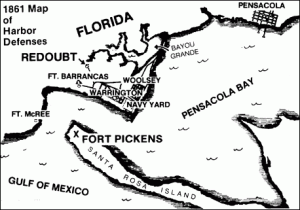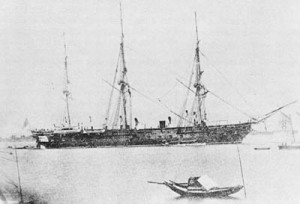150 years ago today early in the AM Union forces from the USS Colorado off Pensacola boarded the suspected privateer Judah at Confederate-held the Navy yard. The Confederates on Judah fought the Federals, but the ship was successfully set
afire and cut loose. It eventually sunk off Fort Barrancas.
From The New-York Times October 20, 1861:
THE DESTRUCTION OF THE JUDAH.; OFFICIAL REPORT OF THE RECENT NAVAL EXPLOIT AT PENSACOLA. COMPLIMENTARY LETTER OF THE SECRETARY OF THE NAVY. PROMOTION OF LIEUT. RUSSELL.
Flag Officer MERVINE has made the subjoined official report to Mr. WELLES, Secretary of the Navy:
UNITED STATES FLAGSHIP COLORADO, OFF FORT PICKENS, Sept. 15,1861.
SIR: I have the honor to inform you that a boat expedition was fitted out from this ship on the night of the 13th instant, consisting of the first launch, and first, second and third cutters, under the commands of Lieuts. RUSSELL, SPROSTON, BLAKE, and Midshipman STEECE, respectively, assisted by Capt. REYNOLDS, of the Marines, Assistant Surgeon KENNEDY, Assistant Engineer WHITE, Gunner HORTON, and Midshipmen FORREST and HIGGINSON. The whole force detailed consisted of about one hundred men, officers, sailors and marines. The object of the expedition was the destruction of a schooner which lay off the Pensacola Navy-yard, supposed to be fitting out as a privateer, and the spiking of a gun, in battery, at the southeast end of the yard.
The movements of the schooner had been assiduously watched for several days and nights, and I deemed it so morally certain that she was intended for a privateer that I determined the attempt should be made to destroy her, even in the face of the fearful odds which would have to be encountered. Lieut. RUSSELL had charge of the expedition, and, with Lieut. BLAKE, was to attack the vessel, while Lieut. SPROSTON and Midshipman STEECE spiked the guns.
The attack was made on the morning of the 14th inst., at 3 1/2 o’clock. The schooner, named the Judah, was found moored to the wharf, under the protection of a battery and field-piece, and to be armed with a pivot and four broadside guns. Her crew were on her, and prepared to receive our forces, pouring in a volley of musketry as the boat neared the vessel. A desperate resistance was made from the decks of the schooner, but the men were driven off on to the wharf by our boarders, where they rallied and were joined by the guard, and kept up a continued fire upon our men.
In the meantime the vessel was set on fire in several places. That which finally consumed her was lighted in the cabin by Assistant Engineer WHITE and a coal-heaver, PATRICK DRISCOLL, who went as a volunteer. She burned to the water’s edge, and has since, while burning, been set free from her moorings, and has drifted down opposite Fort Barrancas, where she sunk.
Of the party assigned to the spiking of the gun, only Lieut. SPROSTON and Gunner HORTON were able, after considerable search, to find it, the party becoming separated in the darkness. No opposition was made to their landing; Midshipman STEECE, with his command, had gone to the aid of those on the schooner, where he performed valuable service. Very fortunately, only one man was found in charge of the gun, and he immediately leveled his piece at Lieut. SPROSTON, but was shot down by Gunner HORTON before he could obtain certain aim. Both pieces exploded simultaneously. The gun, which was found to be a 10-inch columbiad, was immediately spiked, and. bringing off its tompion, these two officers returned to their boat.
The work proposed having thus been well and thoroughly done in the short space of fifteen minutes, and the whole force of the enemy in the yard — reported by deserters as over one thousand strong — being aroused, our boats pulled away, and rallying at a short distance from the shore, fired six charges of canister from their howitzer into the yard, with what result it is impossible to say. Three of the enemy are known to have been killed, and our officers are confident the number is much larger. The boats then returned to the ship, arriving there about daylight.
But, Sir, I am grieved to report that this brilliant affair was not unattended with loss on our side. I have to report as killed by shots from the crosstrees of the schooner, while the boats were approaching, Boatswain’s Mate, CHARLES H. LAMPHERE, and JOHN R. HERRING, seaman and captain of the howitzer –two of the best men in our ship — and marine JOHN SMITH — the first man to board the schooner, and who behaved most gallantly — who was by a sad mistake, having lost his distinguishing mark, killed by one of our own men. We have wounded, probably mortally, seamen R. CLARK and E.K. OSBORN; severely, nine other seamen. Capt. REYNOLDS received a severe contusion on his shoulder, and Midshipman HIGGINSON had the end of his thumb cut off. Lieutenants RUSSELL and BLAKE had narrow escapes, the flesh of each being grazed by one or more musket balls.
It is not an easy task to select individual instances of bravery or daring where all behaved so gallantly. The officers unite in giving great credit to the coolness and bravery with which they were supported by the men, and the latter have learned to look with new pride and confidence on the former. The marines, especially seem to have sustained the reputation borne by their branch of the service, as they receive encomiums from all sides. Assistant-Surgeon KENNEDY rendered valuable assistance in the care of the wounded. Assistant-Engineer WHITE brought down from the cross-trees of the schooner a man who had been seen to fire upon the boats, killing him instantly. I inclose herewith a complete list of all engaged in the affair, with the names of the killed and wounded in each boat.
I have the honor to be, very respectfully, your obedient servant, WM. MERVINE,Flag-officer commanding Gulf Blockading Squadron.
P.S. — By a strange inadvertency, my mind being so much engrossed with the expedition itself, I omitted to give credit to Capt. BAILEY, of this ship, for Maturing the plan and taking charge of fitting out the expedition to the minutest details. It is to his thoughtfulness that a great portion of its success must be ascribed. …
Later in the article The Times reproduces a letter from the U.S. secretary of the Navy, Gideon Welles, promoting John Henry Russell.


